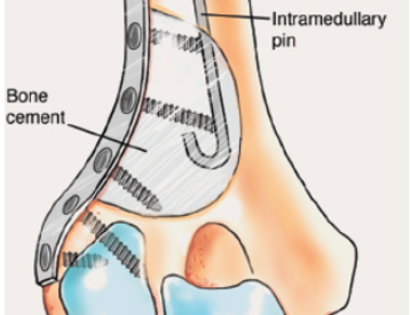Fibrous Dysplasia
Fibrous dysplasia is not considered a tumor, but a developmental disorder of the bone. Commonly affected areas include the facial bones (craniofacial), femur, tibia, and ribs.

Fibrous dysplasia is not considered a tumor, but a developmental disorder of the bone. Commonly affected areas include the facial bones (craniofacial), femur, tibia, and ribs.





Fibrous Dysplasia is a developmental disorder of the bone, which is caused by the inability of the bone-forming tissue to produce mature bone. It can present as one area of bone damage (lesion) or multiple lesions. It is benign, but those particularly with multiple lesions will lead to micro fractures.





Fibrous Dysplasia is a benign, noncancerous developmental disorder, but can lead to deformity and pathological fracture. Tumors can weaken the bone and result in a fracture (pathological fracture) and may require various orthopedic treatments and fixation methods to either treat a fracture or prevent a fracture from occurring (prophylactic fixation). Fixation can be with special prosthetic and joint replacements, metal rods or plates and screws. Cement may be used to strengthen the bone and make the fixation methods more durable.
An example of a Fibrous Dysplasia MRI is shown.
If asymptomatic, no treatment is necessary. Patients can be followed periodically if new symptoms occur. If symptoms are experienced, surgical management includes a procedure called internal fixation incase of weakened bones, bone lesion curettage, bone grafting ,and insertion of fixation rods, plates, and screws.

Intralesional Curettage means to scoop the tumor out using a spoon-like tool called a curette. This is a surgery that aims to remove the mass and restore the bone so that the patient can get back to normal function. The ABC is identified within the bone and scooped, or curetted, out. The cavity is then shaved down with a Midas Rex Drill, which is similar to a dental drill. This drill removes more tumor cells.

The empty bone cavity is usually filled with bone graft or bone cement. Bone can be donated (allograft) or taken from the patient themselves (autograft). Fixation devices, such as a plate and screws, may be used in specific situations to prevent postoperative fracture.

I've seen many doctors and I can confidently attest Dr. Wittig is the preeminent orthopaedic specialist. He is genuinely kind and caring, as he demonstrated by completely addressing my concerns and compassionately relating to what I was dealing with. He clearly outlined the plan of attack, and recommended the two additional doctors who would become part of my 'team'. Dr. Wittig was so effective in allaying our fears and bringing us optimism. My surgery was significant, but I was up and walking the next day and back at the gym 5 weeks later. This is further testament to Dr. Wittig's skill. He saved my leg and my life, and I feel so very blessed to say he is my doctor. I have already recommended him to others, and I will continue to do so. I would trust him with my closest family and lifelong friends. BEST DOCTOR EVER.
S.G.

Myself and my amazing team are dedicated to saving your life and your limb. Losing a limb because of a tumor can be a terrifying experience. But, it does not have to be the only option. I’ve spent 20+ years as a Board-Certified Orthopedic Surgeon and Orthopedic Oncologist.
I’ve devoted my career to helping children and adults afflicted with bone and soft tissue masses by performing complex limb saving surgeries. Most patients can have their limb saved, which may require innovative techniques.
Patients afflicted with musculoskeletal tumors have complex conditions that are best taken care of at large hospitals. I am the Chairman of Orthopedics and Chief of Orthopedic Oncology at Morristown Medical Center. My philosophy is a multidisciplinary team approach, working together to tailor treatment to individual patients. Education and research are essential to my practice, providing the best setting for extraordinary patient care. Because of this, we have some of the top results in the country.